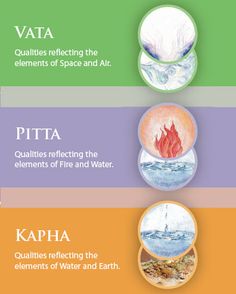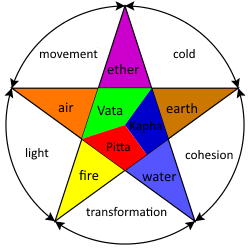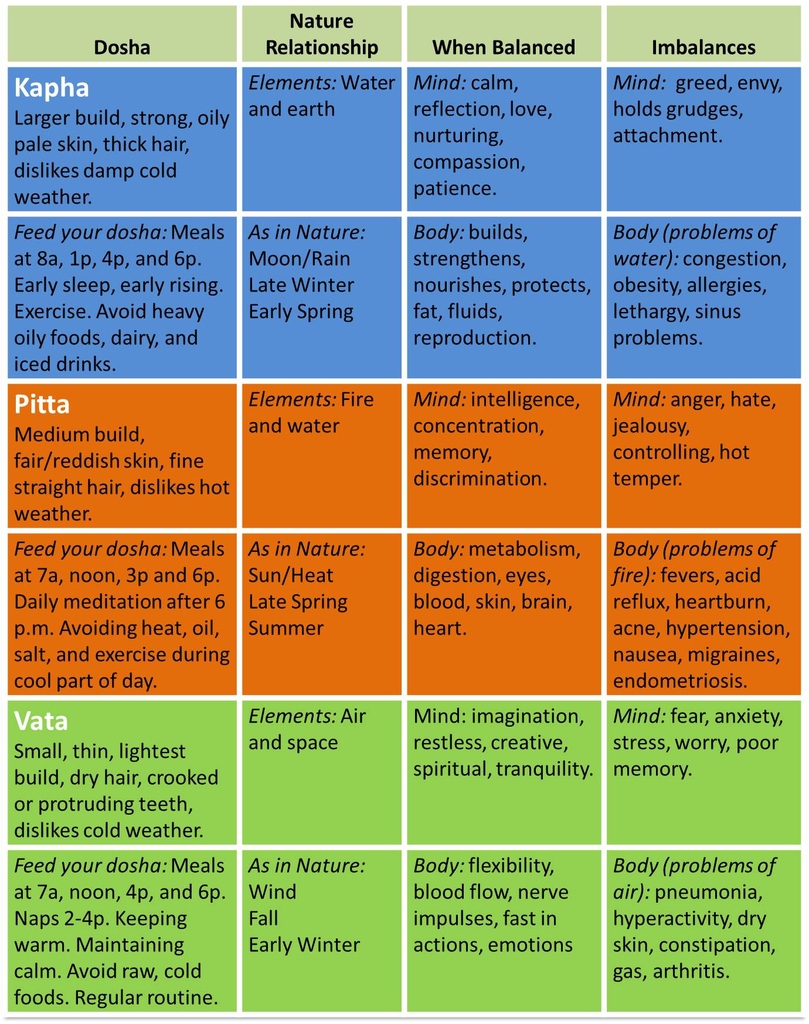Vata, Pitta, Kapha – the Ayruvedic Doshas that govern your body balance
- the body and mind are completely and indistinguishably connected with one another
- nothing has more power to heal the body than the mind

In Ayureda, each person is viewed as a unique individual comprised of the five archetypical elements (earth, air, fire, water, and ether/space). Each element has inherent energies that govern their function, and certain elements combine to create various physiological functions. These are the known as the Doshas.
VATA – Ether and air combine to form Vata Dosha. Vata governs the principle of movement and therefore can be seen as the force which directs nerve impulses, circulation, respiration, and elimination.
PITTA – Fire and water combine to form Pitta. The Pitta Dosha is the process of transformation or metabolism. The transformation of foods into nutrients that our bodies can assimilate is an example of a Pitta function. Pitta is also responsible for metabolism in the organ and tissue systems as well as cellular metabolism.
KAPHA – Water and Earth combine to form the Kapha Dosha. Kapha is what is responsible for growth and protection. Cerebral-spinal fluid protects the brain and spinal column and is a type of Kapha found in the body. Also, the mucosal lining of the stomach is another example of the Kapha dosha protecting the tissues.
In Ayurveda, we are all made of unique proportions of Vata, Pitta and Kapha and explains why one person might respond differently to a variety of stimuli differently than another. Ayurvedic theory is that health exists when there is a balance between Doshas; when any one becomes accumulated, this results in an unbalance within ourselves.

Each Dosha has specific physical & emotional characteristics, seen below in this chart.

There are also many resources available online to help you determine what your Dosha is, you can do a self-quiz here and here.
Once you’ve determined what your ideal balance it, you can determine what you need to do to find that balance. One method of finding balance is with food. Ayurveda identifies tastes of foods – sweet, sour, salty, bitter, pungent, and astringent – rather than individual components of foods – carbohydrates, protein, fats, and calories. Each taste has specific effects on the three Doshas; a food’s taste classification will either aggravate (imbalance) or pacify (balance) a particular Dosha.
To balance your Dosha, view one of these Ayurvedic food programs from pranamama.biz
Sources:
University of Maryland Medical Center http://umm.edu/health/medical/altmed/treatment/ayurveda
Chopra Centered Lifestyle http://www.chopra.com/ccl/what-is-ayurveda
Web MD http://www.webmd.com/balance/guide/ayurvedic-treatments?page=1
Kripalu Centre for Yoga & Health http://www.kripalu.org/article/223/
Wikipedia http://en.wikipedia.org/wiki/Ayurveda
http://en.wikipedia.org/wiki/Dosha
Mind Body Green http://www.mindbodygreen.com/0-1117/Ayurveda-Dosha-Types-for-Beginners.html
University of Minnesota http://www.takingcharge.csh.umn.edu/explore-healing-practices/ayurvedic-medicine/what-philosophy-ayurvedic-medicine
© Trina Waller and Western Canadian Health Products Ltd., 2014 – 2017. All rights reserved. Unauthorized use and/or duplication of this article, and the material contained within, without express written permission from this blog’s author and/or owner is strictly prohibited. Excerpts and links may be used, provided that full and clear credit is given the post author, Western Canadian Health Products Ltd., and WholeHealthatHome.com, with appropriate and specific direction to the original content.
Disclaimer: The content of this website is provided for informational purposes only. It is not intended as medical advice and should not be construed as such. Light devices are not intended to cure, treat, or prevent any disease or illness. If you have a disease or illness, consult with your physician or health care provider prior to using any light device. Use only as directed by manufacturer.
